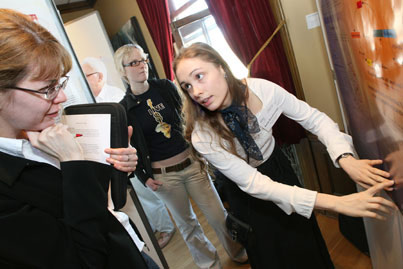Symposium bridges disciplines

L-R: Stella Melo, of the Canadian Space Agency’s Atmospheric Sciences Program, and Libby Sharman-Harris, McGill Earth and Planetary Science PhD student, watch the presentation of Annie Bourbonnais of the GEOTOP-UQAM-McGill Research Centre.
A physicist, a biologist and a chemist walk into a bar. That was essentially the scene at the fourth annual Interdisciplinary Graduate Student Research Symposium, except that, at least for now, the young scientific minds meeting upstairs at Thomson House were doing so over coffee and cookies instead of cocktails. The cocktails would come later, after the two-day symposium had drawn to a close and the bonds that had been formed were ready to be solidified in a more social setting.
Hosted by McGill’s Post-Graduate Students’ Society, the March 29-30 symposium gave young researchers from McGill, other Montreal-area universities and one or two more farther afield the opportunity to present their latest work as well as to network and commiserate with fellow students who, like them, often toil in obscurity in pursuit of a research breakthrough. Topics ranged from climate change to computational modelling and beyond.
“Scientists, especially when they’re starting out, are extremely curious,” said Ed Hudson, an Environmental Chemistry student at McGill and one of the organizers of the symposium. “They’re working passionately on a whole bunch of fascinating problems, but they tend to be isolated because of their work.”
As a presenter in the symposium’s inaugural year and an organizer ever since, Hudson has seen the annual gathering grow both larger and more diverse over the years, allowing a cross-section of McGill’s best and brightest to exchange with their peers from other McGill departments as well as from other universities.
“This event provides the opportunity to form collaborations that wouldn’t happen otherwise,” said Maria de Boef, a Biology student who has made some valuable connections through her involvement with the annual symposium.
“I’ve found people doing what I’m doing and it’s really opened my eyes to how much is going on at McGill,” she said.
The punchline, she has found, is that even if a physicist, a biologist and a chemist walk into this particular venue, there is likely to be little disagreement among them.
“There’s always the possibility of forming collaborations that would never happen otherwise,” she said. “And even if you don’t get to the collaboration stage, it’s nice to know that someone in Physics thinks that what you’re doing is cool.”

